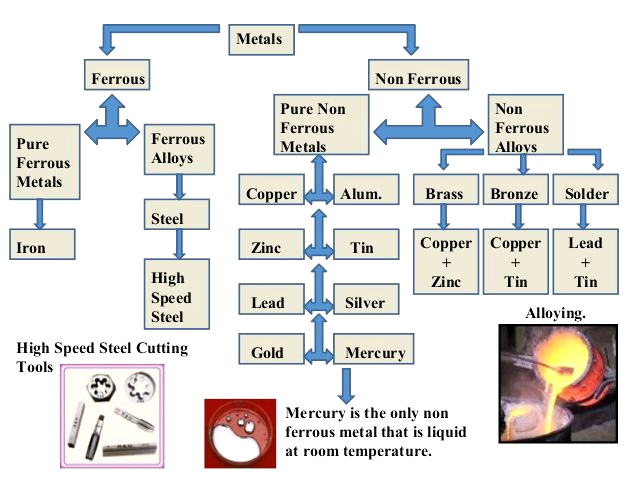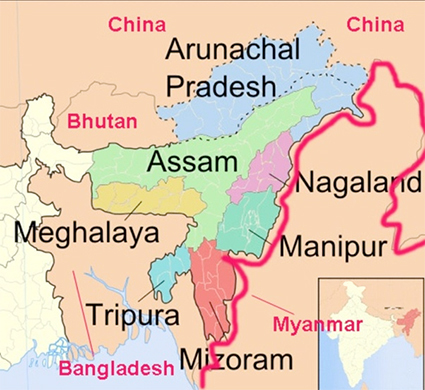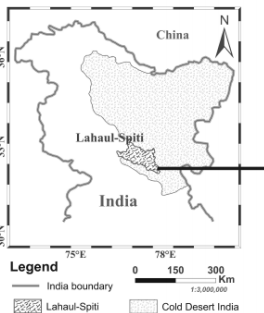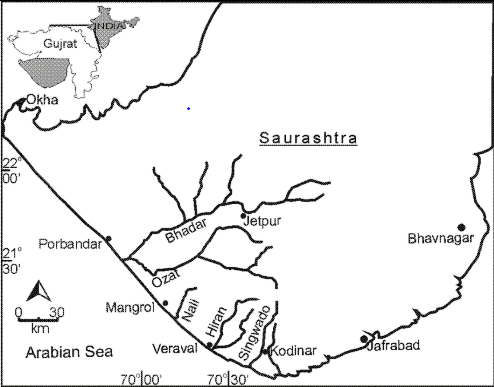Growth in Bank Credit & Deposits: RBI
Why in News
Recent data released by the Reserve Bank of India (RBI) showed that Bank credit and deposits grew and were higher in February 2021 than January 2021.
- The credit and deposits for February 2021 were even higher than the pre-pandemic data of February 2020.
Key Points
- Bank Related Data by RBI:
- At the end of February 2021:
- Bank credit grew by 6.63% to Rs.107.75 lakh crore which in February 2020 stood at Rs.101.05 lakh crore.
- Bank deposits grew by 12.06% to Rs.149.34 lakh crore which in February 2020 stood at Rs.133.26 lakh crore.
- At the end of February 2021:
- Reason for Credit Growth:
- The growth in bank credit is driven by an increase in retail loans.
- Retail loans include a vast range of different loans. Personal loans such as car loans, mortgages, signature loans and credit cards all fall into the category of retail loans, but business loans can also fall into the category of retail loans.
- The overall retail credit growth, which is currently at 9% is expected to accelerate further, led by mortgages (contributing 51%of retail loans) and back-end support by unsecured (cards/personal loans) and vehicle loans.
- The growth in bank credit is driven by an increase in retail loans.
- Bank Credit:
- Banks and financial institutions make money from the funds they lend out to their clients.
- These funds come from the money clients deposit in their accounts or invest in certain investment vehicles such as certificates of deposit (CDs).
- A CD is a product offered by banks and credit unions that provides an interest rate premium in exchange for the customer agreeing to leave a lump-sum deposit untouched for a predetermined period of time.
- These funds come from the money clients deposit in their accounts or invest in certain investment vehicles such as certificates of deposit (CDs).
- Bank credit consists of the total amount of combined funds that financial institutions advance to individuals or businesses. It is an agreement between banks and borrowers where banks make loans to borrowers.
- Banks and financial institutions make money from the funds they lend out to their clients.
- Bank Credit In India:
- The Bank credit in India refers to credit lending by various scheduled commercial banks (SCBs) to various sectors of the economy.
- The bank credit is categorized into food credit and non-food credit.
- The food credit indicates the lending made by banks to the Food Corporation of India (FCI) mainly for procuring foodgrains. It is a small share of the total bank credit.
- The major portion of the bank credit is the non-food credit which comprises credit to various sectors of the economy (Agriculture, Industry, and Services) and also in the form of personal loans.
- The data on bank credit is collected on a monthly basis by the RBI.
- Bank Deposits:
- Bank deposits consist of money placed into banking institutions for safekeeping. These deposits are made to deposit accounts such as savings accounts, current accounts, and money market accounts.
- The account holder has the right to withdraw deposited funds, as set forth in the terms and conditions governing the account agreement.
- Bank deposits consist of money placed into banking institutions for safekeeping. These deposits are made to deposit accounts such as savings accounts, current accounts, and money market accounts.
- Bank Deposits in India: In India there are four major types of Bank Deposits
- Current Account:
- A current account is a special type of account that has lower restrictions than a savings account when it comes to withdrawals and transactions.
- It is also known as a demand deposit account and it is meant for businessmen to conduct their business transactions smoothly.
- Banks also offer overdraft facilities on these, i.e., they let account-holders withdraw more money than there is in the account.
- Savings Accounts:
- It offers high liquidity and is very popular among the masses. It does, however, have cash withdrawal and transaction limits to promote digital payments.
- Banks provide an interest rate which is only slightly higher than inflation, so it is not very optimal for investment.
- Recurring Deposits:
- It is a special type of term deposit where you do not need to deposit a lump sum savings rather a person has to deposit a fixed sum of money every month.
- There are no premature withdrawals allowed in the account, but for a penalty, you can close the account before the maturity date of the deposit.
- Fixed Deposits:
- It is an investment avenue offered by banks, financial institutes and Non-Banking Financial Companies (NBFCs) that offers guaranteed returns.
- It gives a higher interest than a regular savings account and offers a wide range of tenures ranging from 7 days to 10 years.
- Current Account:
National Non-ferrous Metal Scrap Recycling Framework
Why in News
The Ministry of Mines has issued a National non-ferrous metal scrap recycling framework, 2020 in a bid to cut down the scrap imports.
- It also seeks to use a life cycle management approach for better efficiency in the mineral value chain process.
Key Points
- Objectives of the Recycling Framework:
- To work towards economic wealth creation, job creation and increased contribution to GDP through metal recycling.
- To promote a formal and well organized recycling ecosystem by adopting energy efficient processes.
- To minimize the effect of end of life products on landfills and environmental pollution by promoting an environmentally sound recycling system.
- To evolve a responsive ecosystem by involving all stakeholders.
- Implementation Guidelines:
- The framework envisages setting up of a central Metal Recycling Authority to facilitate recycling of metals.
- The government will work towards establishing standards for Quality of scrap used for recycling.
- A mechanism for registration of segregators, dismantlers, recyclers, collection centers etc. will be developed to promote recycling to an organized sector
- It is proposed to set up Urban Mines, envisaged as a location to collect and hold large quantities of similar materials.
- An Online market platform/ exchange platform for recycled/secondary metal will be developed.
- Recyclers may explore the possibility of entering into collection contracts with industrial and commercial establishments.
- Roles/ Responsibilities of Stakeholders:
- Responsibility of Manufacturer: To ensure that any Extended Producer Responsibility (EPR) guidelines/Regulations be strictly adhered to.
- Designing products that are easier to recycle and reuse in an efficient and environmentally sound manner.
- Role of Public: Public should responsibly dispose of scrap at designated scrap collection centers for their effective and environmentally sound processing.
- Role of Government: MoEF&CC to streamline the regulatory requirements, eliminating multiple clearances wherever feasible, for the recycling units.
- Role of Recycling Authority: Developing technical, safety and environmental norms and SOPs for handling and processing of scraps in consultation with MoEFCC, CPCB, BIS, etc.
- Responsibility of Manufacturer: To ensure that any Extended Producer Responsibility (EPR) guidelines/Regulations be strictly adhered to.
- Challenges Faced By the Non-ferrous Metals Recycle Industry:
- A major challenge is its heavy dependence on import of metal scrap.
- Lack of an organized / systematic scrap recovery mechanism.
- Lack of sustained implementation of existing regulations on waste collection and recycling.
- Lack of standardization of recycled products adversely affecting market adoption.
- Lack of specific skill sets on responsible methods and technologies.
- Government Initiatives For Recycling
- The Ministry of Environment, Forest and Climate Change (MoEF&CC) is in the process of formulating National Resource Efficiency Policy (NREP) which aims to mainstream resource efficiency across all sectors, wherein Aluminium sector has been considered as a priority sector.
- The Ministry of Steel has brought out a Steel Scrap Recycling Policy which envisages a framework to facilitate and promote establishment of metal scrap recycling centers.
- NITI Aayog is proposing a comprehensive “National Material Recycling Policy” to drive concerned and coordinated national and state level programs, plans and actions towards ramping up material recycling in India in a formal and organized manner.
Non-Ferrous Metal
- The Non-ferrous metals can be classified in broad categories as
- Base metals (e.g. aluminium, copper, zinc, lead, nickel, tin)
- Precious metals (e.g. silver, gold, palladium, other platinum group metals)
- Minor metals including refractory metals (e.g. tungsten, molybdenum, tantalum, niobium, chromium) and
- Specialty metals (e.g. cobalt, germanium, indium, tellurium, antimony, and gallium).
- Aluminium is the second most used metal in the world after Iron.
- Copper is the third most important base metal by value.
- Zinc is the fourth most widely used metal across the globe.
Illegal Influx from Myanmar
Why in News
Recently, the Ministry of Home Affairs (MHA) has directed Nagaland, Manipur, Mizoram and Arunachal Pradesh to check illegal influx from Myanmar into India.
- The instructions have also been given to Border Guarding Force (BGF), i.e. Assam rifles.
- India already has a lot of Rohingya migrated from Myanmar.
- India, treats all refugees entering the country as illegal immigrants.
- In 2020, it was estimated that 40,000 Rohingya refugees lived in India, scattered across different states.
Key Points
- MHA’s Instructions:
- The State governments have no powers to grant “refugee status to any foreigner” and India is not a signatory to the United Nations Refugee Convention of 1951 and its 1967 Protocol.
- Similar Instructions were Issued in August 2017 and February 2018.
- The State governments have no powers to grant “refugee status to any foreigner” and India is not a signatory to the United Nations Refugee Convention of 1951 and its 1967 Protocol.
- Background:
- The directive comes weeks after the military coup and subsequent crackdown in Myanmar which led to several persons crossing over into India.
- The Tatmadaw, or Myanmar military, had taken over the country after a coup in February 2021.
- North Eastern States readily provide shelter to people from across the border as some of the states have cultural ties with some border areas of Myanmar and many people have family relations as well. This had resulted in some states taking a sympathetic view of those fleeing Myanmar and giving them shelter.
- Already there are clashes among the tribes (example Bru), more refugees will further aggravate the situation.
- Recent Influx:
- More than a dozen foreign nationals including policemen and women from Myanmar have fled to neighbouring Mizoram.
- India Myanmar Border:
- India and Myanmar share a 1,643 km border and people on either side have familial ties.
- Mizoram shares 510-km.
- Manipur shares 398-km.
- Arunachal Pradesh shares 520 kms.
- Nagaland shares 215 kms
- The border along the four states is unfenced and porous.
- India and Myanmar share a 1,643 km border and people on either side have familial ties.
- Free Movement Regime:
- A Free Movement Regime (FMR) exists between India and Myanmar.
- Under FMR every member of the hill tribes, who is either a citizen of India or a citizen of Myanmar and who is resident of any area within 16 km on either side of the Indo-Myanmar Border (IMB) can cross the border with a border pass (with one-year validity) issued by the competent authority and can stay up to two weeks per visit.
United Nations Refugee Convention 1951
- It is a United Nations multilateral treaty that defines who is a refugee, and sets out the rights of individuals who are granted asylum and the responsibilities of nations that grant asylum.
- It also set out which people do not qualify as refugees, such as war criminals.
- It grants certain rights to people fleeing persecution because of race, religion, nationality, affiliation to a particular social group, or political opinion.
- The Convention also provides for some visa-free travel for holders of travel documents issued under the convention.
- The Convention builds on Article 14 of the Universal Declaration of Human Rights 1948, which recognizes the right of persons to seek asylum from persecution in other countries.
- A refugee may enjoy rights and benefits in a state in addition to those provided for in the Convention
- The 1967 Protocol included refugees from all countries as opposed to the 1951 Convention that only included refugees from Europe.
- India is not a member of this convention.
State Election Commission Appointment Issue
Why in News
The Supreme Court ruled that serving bureaucrats must not be appointed as election commissioners to ensure that the independence of the office of the election commissioner is not compromised.
Key Points
- Background:
- A Bench of the Supreme Court was hearing an appeal by the Goa government against an order of the Bombay High Court.
- The Bombay High Court had earlier castigated the State Election Commission (SEC) for not acting independently to ensure that the mandate of the Constitution was followed before issuing an election schedule.
- Also, the Court had issued a stay on certain municipal election notifications issued by the Goa State Election Commission.
- The territorial jurisdiction of Bombay High Court extends to Maharashtra, Goa, Dadra and Nagar Haveli and Daman and Diu.
- During the proceedings it came to notice that the law secretary of the Goa state was given ‘additional charge’ of the State Election Commission.
- Supreme Court’s Ruling:
- Independent persons and not government employees should be appointed Election Commissioners.
- Giving government employees additional charge as Election Commissioners is a mockery of the Constitution.
- Directed States to comply with the constitutional scheme of independent and fair functioning of election commissions.
- If they hold any such office (under the state government), then they have to resign before taking charge of the office of the election commissioner.
- Ordered all state governments to appoint whole-time election commissioners who will act independently and fairly.
- Independent persons and not government employees should be appointed Election Commissioners.
- About State Election Commissions (SECs):
- The State Election Commission has been entrusted with the function of conducting free, fair and impartial elections to the local bodies in the state.
- Article 243K(1): It states that the superintendence, direction and control of the preparation of electoral rolls for, and the conduct of, all elections to the Panchayats (Municipalities under Article 243ZA) shall be vested in a State Election Commission consisting of a State Election Commissioner to be appointed by the Governor.
- Article 243K(2): It states that the tenure and appointment will be directed as per the law made by the state legislature. However, State Election Commissioner shall not be removed from his/her office except in like manner and on the like grounds as a Judge of a High Court.
Suggestions
- Second Administrative Reforms Commission Recommendation (2nd ARC):
- Constitution of the State Election Commission: According to 2nd ARC, the State Election Commissioner (SEC) should be appointed by the Governor on the recommendation of a collegium, comprising the Chief Minister, the Speaker of the State Legislative Assembly and the Leader of Opposition in the Legislative Assembly.
- An institutional mechanism should be created to bring the Election Commission of India and the SECs on a common platform for coordination, learning from each other’s experiences and sharing of resources.
- Law Commission 255th Report on Electoral Reforms:
- It recommended, to add a new sub-clause to Article 324 of the Constitution to provide for a separate independent and permanent Secretariat for the Election Commission of India (ECI) along the lines of the Lok Sabha/Rajya Sabha Secretariats under Article 98 of the Constitution.
- Similar provisions can also be made for the State Election Commissions to ensure autonomy, and free and fair local body election.
New Technique for Monitoring of Power Transmission Cables
Why in News
Recently, researchers at IIT Madras have demonstrated that power transmission cable can be monitored by using Raman thermometry on the fibre optic cable.
- They achieved this by using the optical fibres that are already embedded in the power cables for establishing optical communication.
Key Points
- Raman Thermometry:
- It is a thermal characterization technique which makes use of Raman scattering phenomena to determine the local temperature in microelectronics systems.
- When light is scattered off an object, say a molecule, two bands are observed, with higher and lower frequency than the original light, called the Stokes and anti-Stokes bands, respectively.
- By studying the relative intensity of the two bands, it is possible to estimate the temperature of the object which scatters the light.
- The anti-Stokes component of Raman scattering is strongly dependent on the temperature that the material is subjected to. Thus, by measuring the intensity of the anti-Stokes scattered light we can estimate the temperature.
- Any current flowing through a conductor would cause a temperature rise due to the Joule heating effect. Hence the flow of current through the power cables results in heating of the power cables.
- Joule heating (also referred to as resistive or ohmic heating) describes the process where the energy of an electric current is converted into heat as it flows through a resistance.
- Optical Fibre Technique:
- The temperature measurement of wires is performed in not just one location, but in a distributed manner using an optical fibre. To achieve this, a pulse of light is launched into the optical fibre and the backscattered radiation is observed.
- Optical fibres are fabricated with high quality composite glass/quartz fibres.
- Each fibre consists of a core (denser) and cladding (rarer).
- When a signal in the form of light is directed at one end of the fibre at a suitable angle, it undergoes repeated total internal reflections along the length of the fibre and finally comes out at the other end.
- Total internal reflection is complete reflection of a ray of light within a medium such as water or glass from the surrounding surfaces back into the medium.
- Since light undergoes total internal reflection at each stage, there is no appreciable loss in the intensity of the light signal.
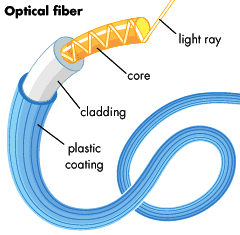
- Optical fibres are fabricated with high quality composite glass/quartz fibres.
- The time of flight of the backscattered radiation provides an estimate of the distance from which the light is backscattered.
- Backscattering (or backscatter) is the reflection of waves, particles, or signals back to the direction they came from.
- This constitutes a distributed measurement as the pulse propagates all along the length of fibre.
- This can go up to tens of kilometers.
- The temperature measurement of wires is performed in not just one location, but in a distributed manner using an optical fibre. To achieve this, a pulse of light is launched into the optical fibre and the backscattered radiation is observed.
- Significance:
- Actual Temperature Measurements:
- The use of Raman thermometry technique allows the operators to get the results for actual temperature measurements over tens of kilometres.
- Economic and Real-Time:
- Alternative methods of measuring the temperature of power cables include using a thermal camera which is cumbersome. The present method devised by the team is both economical and provides real-time information.
- Thermal cameras detect temperature by recognizing and capturing different levels of infrared light.
- Alternative methods of measuring the temperature of power cables include using a thermal camera which is cumbersome. The present method devised by the team is both economical and provides real-time information.
- Actual Temperature Measurements:
Raman Effect
- The Raman Effect or Raman Scattering is a phenomenon in spectroscopy discovered by the eminent physicist Sir Chandrasekhara Venkata Raman in 1928.
- In 1930, he got a Nobel Prize for this remarkable discovery and this was the first Nobel Prize for India in the field of Science.
- The Raman Effect is a change in the wavelength of light that occurs when a light beam is deflected by molecules. When a beam of light traverses a dust-free, transparent sample of a chemical compound, a small fraction of the light emerges in directions other than that of the incident (incoming) beam.
- Most of this scattered light is of unchanged wavelength. A small part, however, has wavelengths different from that of the incident light; its presence is a result of the Raman Effect.
Seabuckthorn Plantation in the Cold Desert
Why in News
The Himachal Pradesh government has decided to start planting seabuckthorn in the cold desert areas of the state.
Key Points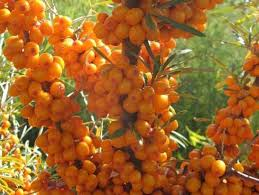
- About Seabuckthorn:
- It’s a shrub which produces an orange-yellow coloured edible berry.
- In India, it is found above the tree line in the Himalayan region, generally in dry areas such as the cold deserts of Ladakh and Spiti.
- In Himachal Pradesh, it is locally called chharma and grows in the wild in Lahaul and Spiti and parts of Kinnaur.
- A major part is covered by this plant in Himachal Pradesh, Ladakh, Uttarakhand, Sikkim and Arunachal Pradesh.
- The Seabuckthorn Plantation has many Ecological, Medicinal and Economical benefits.
- Ecological Benefits:
- Seabuckthorn is a soil-binding plant which prevents soil-erosion, checks siltation in rivers and helps preserve floral biodiversity.
- In the Lahaul valley, where willow trees are dying in large numbers due to pest attack, this hardy shrub is a good alternative for protecting the local ecology.
- Grows well in dry regions and becomes much more important especially in the light of reduced water flow from Himalayan glaciers.
- Medicinal Benefits:
- As a folk medicine, seabuckthorn has been widely used for treating stomach, heart and skin problems.
- Its fruit and leaves are rich in vitamins, carotenoids and omega fatty acids and it can help troops in acclimatising to high-altitude.
- In the last few decades, scientific research worldwide has backed many of its traditional uses.
- Economical Benefits:
- Seabuckthorn also has commercial value, as it is used in making juices, jams, nutritional capsules etc.
- It is an important source of fuelwood and fodder.
- However, wild Seabuckthorn cannot sustainably supply raw material to the industry, and the plant needs to be cultivated on a large scale as is being done in China.
- Ecological Benefits:
Cold Desert in India
- The Cold Desert of India is situated in the Himalayas and stretches from Ladakh in the north to Kinnaur (in the state of Himachal Pradesh) in the south.
- The region has harsh climatic conditions such as very low rainfall and very high elevation (ranging from 3000 – 5000m Above Sea Level)] that adds to the coldness in its environment.
- Blizzards, snowstorms and avalanches are common.
- The soil is not very fertile and the climatic conditions allow very short growing seasons making it a bare landscape.
- Water resources are minimal and comprise glacier-fed streams.
Tree Line
- The tree line is the edge of the habitat at which trees are capable of growing. It is found at high elevations and high latitudes.
- Beyond the tree line, trees cannot tolerate the environmental conditions (usually cold temperatures, extreme snowpack, or associated lack of available moisture).
Bhadar Dam: Gujarat
Why in News
Recently, the Dam Safety Organisation of the Central Water Commission has recommended replacement of floodgates of Bhadar dam which were damaged in the flash flood of 2015.
Key Points
- About Bhadar Dam:
- Bhadar dam is located in Rajkot and is second largest in Saurashtra region after Shetrunji dam.
- Bhadar dam is on the Bhadar River in Saurashtra region in Gujarat.
- Bhadar River:
- The Bhadar is one of the major rivers of Kathiawar (Saurashtra) peninsula in Gujarat.
- It originates near Vaddi in Rajkot district at an elevation of 261 m above mean sea level.
- It flows through the Saurashtra region and finally confluence with Arabian sea at Naviobandar (Porbandar).
- The total length of this river is 198 km. It drains about 1/7th of the area of Saurashtra.
Flash Flood
- Flash floods are typically associated with short, high-intensity rainstorms.
- These are sudden surges in water levels during or following an intense spell of rain.
- These are highly localised events of short duration with a very high peak and usually have less than six hours between the occurrence of the rainfall and peak flood.
- The flood situation worsens in the presence of choked drainage lines or encroachments obstructing the natural flow of water.
Central Water Commission (CWC)
- The Central Water Commission is the apex technical organisation in the country for development of water resources and is an attached organization of the Ministry of Water Resources.
- The Commission is responsible for initiating, coordinating and furthering, in consultation with the State Governments, the schemes for control, conservation, development and utilization of water resources throughout the country for the purpose of irrigation, flood management, power generation, navigation etc.
